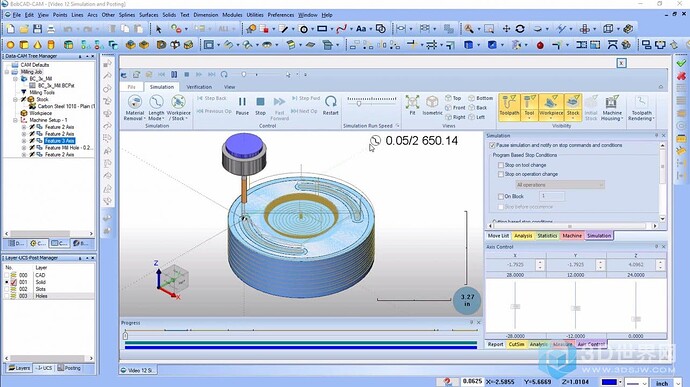Are you wondering which CAM software to choose? Here’s a list of the best CAM software currently available on the market for use with SolidWorks, AutoCAD, and other CAD software. Additionally, we’ll provide you with all the information you need to select the right program based on your requirements!
If you’re new to this and don’t know what CAM software is:
Think of CAM software as Slicer software. It’s the final step in the design process where you prepare the drawings for machine production, whether it’s a milling machine or an FDM 3D printer.
Both processes create objects, but instead of instructing an extruder to add layers of fine filament, CAM software programs factories and other tools to work along predefined paths for objects.
Due to the complexity of parts achievable with subtractive manufacturing, specialized CAM software tools have been developed and excel in areas such as programming paths for turbines.
Advanced CAM software includes a standard automatic feature recognition function. This means the program can recognize features of geometry, such as holes, pockets, and bosses, and then automatically assign the appropriate operations.
Don’t assume for a moment that CAM programming is something anyone can easily learn. But the most advanced CAM software makes the process more efficient and saves you time and money.
Which CAM software should I use?
It largely depends on your design requirements and also on the CAD software you’re already using. Let’s start with the differences in CAM solutions on the market today. There are three basic types of CAM software:
- CAM tools bundled with CAD suites.
- Standalone CAM programs.
- CAM plugins for CAD programs.
CAD/CAM Software
The advantage of CAM features built into many CAD programs is associativity. This important feature refers to the link between the original CAD design and the toolpaths created by the CAM module. It can be a real time and money saver.
Since the toolpath is linked back to the CAD design, any changes are immediately reflected in the toolpath. This means you don’t have to manually re-import the CAD file into external CAM software and then start programming the toolpath from scratch.
As usual, this method has its drawbacks. Often, the CAM operations built into CAD programs are very basic. They are not powerful enough to create toolpaths for highly complex parts with many features.
Standalone CAM Software
On the other hand, dedicated CAM software has powerful CAM operations that can create complex geometries, such as turbines. The downside is the loss of associativity when the native CAD software cannot import. So, it’s crucial that your CAM software and your CAD program support the same file formats. In many cases, “neutral” formats (industry standards like IGES, STEP, STL) will be successful.
In the worst-case scenario, every change in the design requires you to return to the drawing board, in other words, back to the native CAD software, and then start the process of creating toolpaths in the CAM software again.
CAM Software Plugins
There is a middle ground between the two solutions mentioned above, which has all the advantages. Many software developers offer CAM plugins that provide comprehensive CAM functionality for native CAD software. This way, associativity is preserved, and users can benefit from a wide range of tools found in dedicated CAM software.
In the table below, we point out which CAM software is standalone and which can be used as plugins.
| Name | Type | OS | Formats |
|---|---|---|---|
| BobCAD-CAM | Stand-alone/Plugin | Windows | dxf, dwg, iges, igs, step, stp, acis, sat, x_t, x_b, cad, 3dm, sldprt, stl, prt |
| CATIA | Built in | Windows | 3dxml, catpart, igs, pdf, stp, STL, vrml |
| CAMWorks | Plugin | Windows | sab, sat, dwg, dxf, dwf, ipt, iam, idw, model, exp, catpart, catproduct, ai, eps, ad_part, ad_smp, igs, ckd, x_t, x_b, prt, asm, 3dm, par, psm, sldprt,sldasm, stp, step, stl, vda |
| Fusion 360 | Built-In | Windows and Mac | catpart, dwg, dxf, f3d, igs, obj, pdf, sat, sldprt, stp |
| hyperMill | Stand-alone/Plugin | Windows | 3dxml, 3dm, 3ds, 3mf, amf, dwg, dxf, idf, ifc, obj, pdf, sldprt, stp, STL, vrml |
| HSM / HSM Works | Plugin | Windows | catpart, catproduct, prt, sldprt,sldasm, stp, step, stl |
| Mastercam | Stand-alone/Plugin | Windows | sab, sat, dwg, sxf, ipt, iam, idw, model, exp, catpart, catproduct, ad_prt, ad_smp, igs, ckd, x_t, x_b, prt, asm, 3dm, par, psm, asm, slddrw, sldprt, sldasm, stl, vda |
| Powermill | Plugin | Windows | iges, step, stl, catpart, catproduct, nx |
| Siemens NX CAM | Plugin | Windows, macOS, Linux | asm, dat_default, dxf, jt, lek, prt, tso, xli |
| SolidCAM | Stand-alone/Plugin | Windows | 3dxml, 3dm, 3ds, 3mf, amf, dwg, dxf, par, idf, ifc, obj, pdf, sldprt, stp, vrml, igs, ipt, prt, rvt, sldprt, stl, x_b, xgl |
| SolidWorks CAM | Plugin | Windows | 3dxml, 3dm, 3ds, 3mf, amf, dwg, dxf, idf, ifc, obj, pdf, sldprt, stp, STL, vrml |
| SprutCAM | Stand-alone/Plugin | Windows | iges, dxf, stl, vrml, step, sldasm, sldprt, asm, par, psm, pwd |










